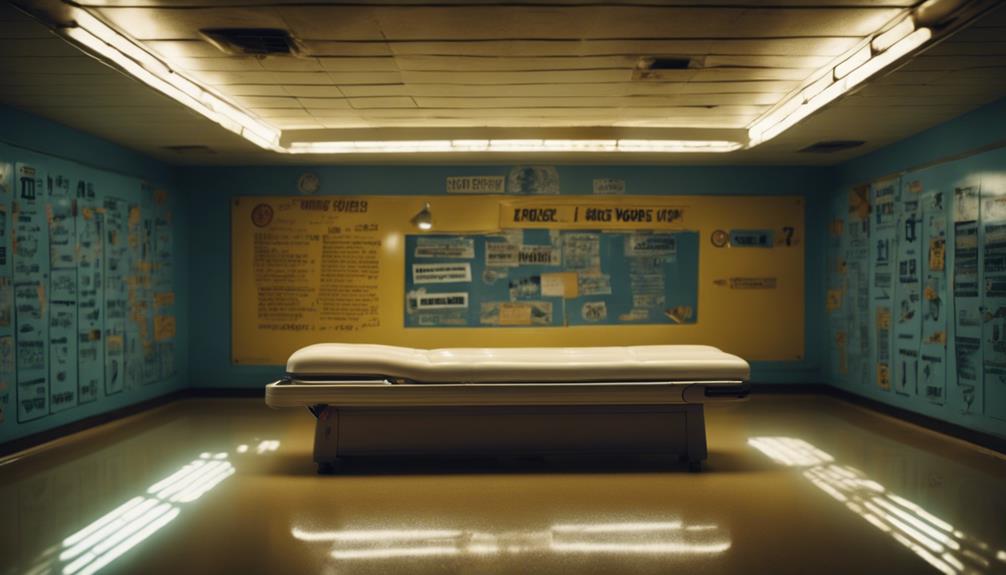Tanning beds might look like a quick fix for a bronzed glow, but let's face it — they come with serious risks you can't ignore! Using them boosts your skin cancer risk by a jaw-dropping 75%, especially if you start young. It's not just about turning brown; those UVA rays also speed up wrinkles and skin damage. Plus, forgetting goggles can leave your eyes in a pinch! It's way safer to try self-tanners or professional sprays for that glowing look without the danger. Curious about the best ways to protect your skin? Keep on exploring for more tips!
Key Takeaways
- Tanning beds increase skin cancer risk by 75%, particularly for melanoma, with early exposure amplifying the danger.
- UV rays from tanning beds penetrate deeply, leading to premature aging, wrinkles, and skin damage.
- A 'base tan' offers minimal protection from UV rays and is not a safe alternative for sun exposure.
- Protective goggles are essential; tanning beds can cause significant eye damage without proper eye protection.
Health Risks of Tanning Beds
Using tanning beds greatly increases your risk of skin cancer, including melanoma, due to the harmful UV radiation they emit. On top of the skin cancer risk, tanning beds can also cause premature aging, wrinkles, and dark spots on the skin. Despite these risks, some people still believe in the benefits of tanning beds, such as getting a quick and easy tan, which can give them a healthy and attractive appearance. However, it is important to weigh these perceived benefits against the real and serious health risks associated with using tanning beds.
You might think a glowing tan looks great, but did you know that using tanning beds raises your risk of melanoma by a staggering 75%? That's like rolling the dice on your health every time you step in!
Early exposure to these rays, especially before you turn 20, can really up your risk. Plus, those sneaky UVA rays dive deeper into your skin, leading to wrinkles and other skin issues.
Usage Recommendations

To minimize skin damage and reduce the risk of skin cancer, limit your tanning bed sessions and follow safety guidelines carefully. You should aim for just a few sessions per month, especially if you have fair skin.
Always wear protective goggles—it's like giving your eyes a cozy blanket against harmful rays! Before tanning, check the equipment and make sure it's clean.
And remember, don't forget to consult a dermatologist for personalized advice; they're like your skin's best friend! If your skin feels red or tender, take a break; it's your body saying, “Hey, slow down!”
Safe Alternatives to Tanning

Self-tanning lotions and sprays offer a safe way to achieve that sun-kissed glow without the harmful effects of UV exposure.
You can easily apply these products at home, and they come in various shades, so you can find the perfect one for your skin tone.
Gradual tanners let you build your color slowly, which means you won't end up looking like a pumpkin!
Professional spray tans are also an option if you want that flawless finish without the DIY hassle.
Plus, bronzing makeup and body shimmer can give you an instant glow for special occasions.
With these fun alternatives, you can rock a radiant look while keeping your skin healthy and protected.
Say goodbye to tanning beds and hello to safe sunless tanning!
Skin Preparation Tips

Exfoliating your skin 24 hours before tanning guarantees an even and smooth application for the best results. It's like giving your skin a fresh start! Make sure to moisturize afterward, too, as hydrated skin absorbs color better. Here's a quick guide to enhance your tanning prep:
| Step | What to Do | Why It Matters |
|---|---|---|
| Exfoliate | Use a gentle scrub | Removes dead skin, smooths texture |
| Moisturize | Apply lotion after exfoliating | Keeps skin hydrated, enhances color |
| Avoid alcohol/fragrance | Skip strong products | Prevents irritation and helps color stick |
Post-Tanning Skin Care

After tanning, proper skin care is essential to maintain your glow and keep your skin healthy.
First, hydrate your skin by applying a soothing lotion or aloe vera gel, which can help calm any redness and prevent peeling.
Remember, your skin just went through a mini vacation, so treat it well! Avoid hot showers and harsh soaps for a few days, as they can strip your skin of moisture. Instead, opt for gentle cleansers.
Don't forget to stay hydrated by drinking plenty of water, too! If you notice any irritation or unusual reactions, don't panic; just reach out to a dermatologist.
Your skin deserves the best post-tanning treatment, so give it the care it needs to shine!
Common Misconceptions

While you're taking care of your skin post-tanning, it's important to address some common misconceptions about tanning beds and their effects on your health.
First off, the idea of a “base tan” is pure myth! You can't protect your skin with a little pre-tanning.
Also, tanning beds aren't a magic source of vitamin D—sorry, sun worshippers! You might think you're getting a quick glow, but that's just leading to serious skin damage in the long run.
And don't rely on SPF alone; goggles are a must to protect your eyes.
Remember, the temporary thrill of a tan mightn't be worth the risks of melanoma and premature aging.
Understanding UV Radiation Effects

Understanding the effects of UV radiation is essential for making informed decisions about tanning and protecting your skin. You might think that a little tanning never hurt anyone, but the truth is, UV rays can cause some serious damage.
Here are four things you really need to know:
- Skin cancer risk: Using tanning beds can raise your risk of melanoma by a whopping 75%!
- Premature aging: Those UV rays speed up aging, giving you wrinkles and sunspots way too soon.
- Eye damage: Not wearing protective goggles? Your eyes could end up paying the price.
- Overexposure: Redness and peeling aren't just annoying; they're warning signs your skin's had enough.
Think twice before you hit the tanning bed! Your skin will thank you later.
Frequently Asked Questions
Can Tanning Beds Cause Immediate Skin Reactions?
Yes, tanning beds can cause immediate skin reactions. You might experience redness, tenderness, or peeling right after a session. It's crucial to monitor your skin closely and stop tanning if you notice any adverse effects.
How Often Should I Get Professional Skin Check-Ups?
Every now and then, you should get professional skin check-ups at least once a year. If you notice any changes or have concerns, don't hesitate to schedule an appointment sooner. Your skin deserves the best care!
What Are the Signs of Tanning Bed Addiction?
If you're noticing cravings for tanning, spending excessive time in beds, or feeling anxious when missing sessions, these might be signs of tanning bed addiction. It's important to recognize these behaviors and seek healthier alternatives.
Are There Any Safe Tanning Bed Brands?
There aren't truly safe tanning bed brands since all emit harmful UV radiation. Instead, consider safer alternatives like self-tanners or bronzers. Prioritize your skin's health and explore options that avoid UV exposure altogether.
How Do I Choose a Reputable Tanning Salon?
Choosing a reputable tanning salon is like finding a trusted chef; prioritize cleanliness, read reviews, check for FDA-approved equipment, and guarantee staff is knowledgeable. A good salon prioritizes your safety and delivers quality service.
Conclusion
So, before you jump into that tanning bed for a 'quick glow,' think about what you're really getting into. The risks are serious, and your skin deserves way better!
Instead of baking under harmful rays, why not try safer alternatives? Your quest for a sun-kissed look can still happen without the dangers lurking in those beds.
Remember, staying healthy and looking fabulous doesn't have to be a gamble—let's make choices that keep your skin glowing for years to come!









